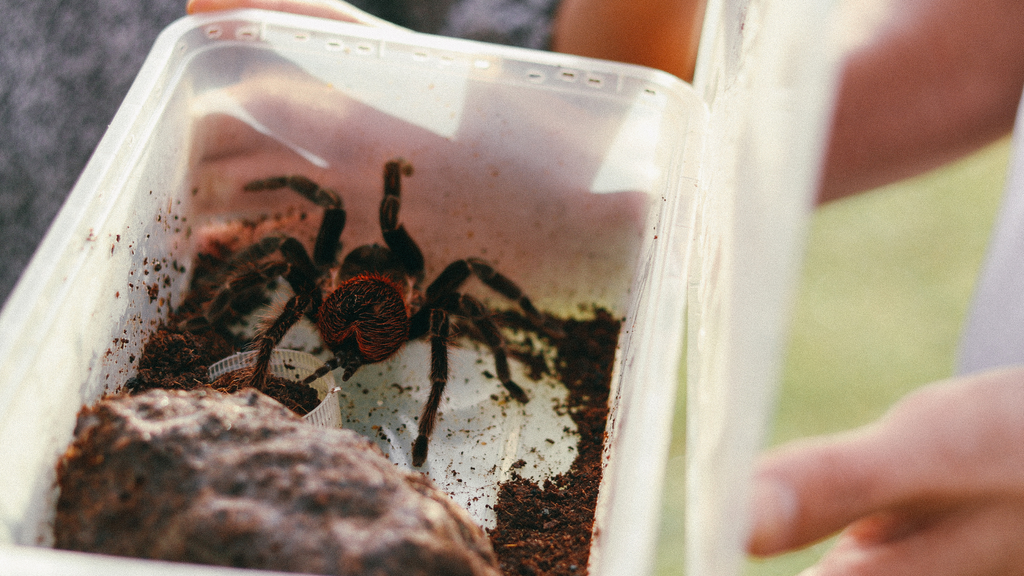Top 10 Common Mistakes in the Tarantula Hobby (and How to Avoid Them)

Whether you're just starting out or have been keeping tarantulas for a while, there's always room to grow and improve your care routine. The tarantula hobby is full of trial and error, and trust me, I’ve made a lot of mistakes along the way. But that’s part of the process! As we continue to learn, we adapt our methods to provide the best care for our eight-legged friends. Let’s go over the top 10 mistakes people commonly make when keeping tarantulas—and how to avoid them.
1. Putting a Sponge in the Water Dish
One of the most outdated pieces of advice I see time and time again is putting a sponge in your tarantula’s water dish. The problem? Tarantulas don’t typically drink from sponges. It’s much easier for them to sip directly from a shallow water dish or even from droplets on their web or the side of their enclosure. Some keepers use sponges to prevent drowning, but this often results in mold and bacteria growth, which can be harmful to your tarantula.
Instead, use a shallow ceramic or plastic dish and keep it filled with fresh water. You can opt for something like these small deli containers or small water bowls. Don’t worry about your tarantula drowning—they can float! If you're concerned about feeder crickets getting stuck, simply place some aquarium gravel in one corner of the dish to give them a way to escape.
2. Misting Every Day
Another common mistake is obsessing over humidity and misting your tarantula’s enclosure daily. While some species, like Theraphosa blondi or Avicularia, thrive in more humid conditions, most tarantulas don’t require daily misting. In fact, constant misting can lead to stagnant air, which can be dangerous, especially in species like Avicularia (where SADS—Sudden Avic Death Syndrome—has been linked to over-misting and poor ventilation).
Instead, focus on creating a well-ventilated enclosure with occasional misting when necessary. A large water dish will generally meet your tarantula’s hydration needs. Remember, humidity shouldn’t be your main focus—airflow is just as important. You can find hand misters here.
3. Using Heat Rocks, Lamps, or Pads
This is a mistake I made early on with my first tarantula, a Grammostola rosea. I was advised to use a heat rock or heat lamp, which, like many new keepers, I assumed was essential. The reality is that tarantulas don’t need UVB lighting or specialized heat sources like reptiles.
Tarantulas are ectothermic, meaning they regulate their body temperature based on their environment. If the room temperature is between 68–76°F, they’re perfectly comfortable. Heat pads or lamps can actually stress your tarantula and cause fatal temperature fluctuations. It’s best to heat the room the tarantula is in, rather than the enclosure itself. If you have a bioactive enclosure, the minimal warmth produced by your plant light should be enough.
4. Placing Enclosures in Direct Sunlight
Setting up your tarantula’s enclosure near a window sounds harmless but can cause serious issues. Direct sunlight can create a greenhouse effect, causing the temperature inside the enclosure to spike. Exposure to temperatures over 90°F or 100°F for prolonged periods can be dangerous, and humidity levels will also drop, leaving your tarantula with an uncomfortably dry environment.
Be mindful of the sun’s path throughout the day. Even if it isn’t directly shining on the enclosure in the morning, it could be by midday. Move your tarantula’s enclosure to a more stable spot, and consider using curtains or blinds to control the sunlight.
5. Poor Ventilation in Enclosures
One of the biggest pitfalls in tarantula husbandry is improper ventilation. This is especially true for DIY enclosures, like the popular Amac boxes. Cross ventilation—holes drilled on opposite sides of the enclosure—is key to keeping airflow moving and preventing mold buildup.
If you’re using a glass aquarium, you can improve ventilation by creating a barrier with acrylic or mesh to ensure proper air circulation. For tarantula slings, simply opening the lid periodically can provide enough air exchange. As they grow, ensure there’s adequate airflow to keep the environment safe and healthy.
The best enclosures I’ve found for tarantulas are Tarantula Cribs or similar. They provide optimal cross-ventilation while maintaining humidity.
6. Using Mesh Lids
Many commercial enclosures come with fine mesh lids, which may work for reptiles but not for tarantulas. A tarantula can easily get its leg stuck in these mesh holes, leading to injury or even death. I’ve seen this happen countless times, and it’s heartbreaking.
Instead, replace the mesh with a solid piece of acrylic or plexiglass. Secure it with silicone and drill a few ventilation holes. You can also purchase premade acrylic lids from companies like Tarantula Cribs. Your tarantula will thank you!
7. Using the Wrong Substrate
For years, I used a variety of substrates, including ReptiBark and aquarium gravel, because I was told those were suitable.
I highly recommend using The Dude's Terra Aranea bioactive-ready substrate. It mimics the natural environment of tarantulas, providing ideal moisture levels, humidity, and texture. This substrate supports burrowing instincts and maintains a healthy microclimate.
Other good choices are ReptiSoil or Peat Moss. Avoid Coco Fiber; although cheap and readily available, it is dusty, hydrophobic, prone to mold, and does not hold burrows well. It works better when mixed with peat moss, pesticide-free potting soil, and a little sand.
8. Overfeeding
 While it’s easy to overfeed your tarantula, it’s important to stick to a schedule. Tarantulas are opportunistic feeders and don’t need daily meals. Overfeeding can lead to obesity and issues during molting.
While it’s easy to overfeed your tarantula, it’s important to stick to a schedule. Tarantulas are opportunistic feeders and don’t need daily meals. Overfeeding can lead to obesity and issues during molting.
Feed slings every 3–4 days, juveniles once a week, and adults every 10–14 days. If your tarantula doesn’t seem interested in food, don’t worry—it’s normal for them to go without eating for weeks or even months.
9. Feeding During Premolt
It’s tempting to offer food to a tarantula that isn’t eating, but you should avoid disturbing them during the premolt. Dropping crickets into the enclosure and leaving them can create dangerous situations, especially if the tarantula molts while the prey is still there.
When molting, tarantulas are soft and vulnerable. Always remove uneaten food after 24 hours to prevent harm.
10. Disturbing During Molting
 Molting is one of the most vulnerable times for a tarantula. The process can take several hours or even a full day, during which your tarantula is extremely fragile. Disturbing them during this time can cause serious injury or death.
Molting is one of the most vulnerable times for a tarantula. The process can take several hours or even a full day, during which your tarantula is extremely fragile. Disturbing them during this time can cause serious injury or death.
If you see your tarantula on its back, do not disturb it! Leave the enclosure alone and give your tarantula time to molt and harden its new exoskeleton before resuming normal care.
Conclusion
These are the top 10 mistakes I’ve either made or seen firsthand in the tarantula hobby. The important thing is recognizing mistakes and adjusting your care routines accordingly. If you’ve made any of these mistakes, don’t stress—just tweak your methods and keep learning. The more we grow as hobbyists, the better care we can provide for our tarantulas. Happy keeping!
Written by Richard Stewart of Tarantula Collective 4/28/2025
- Josh Halter










